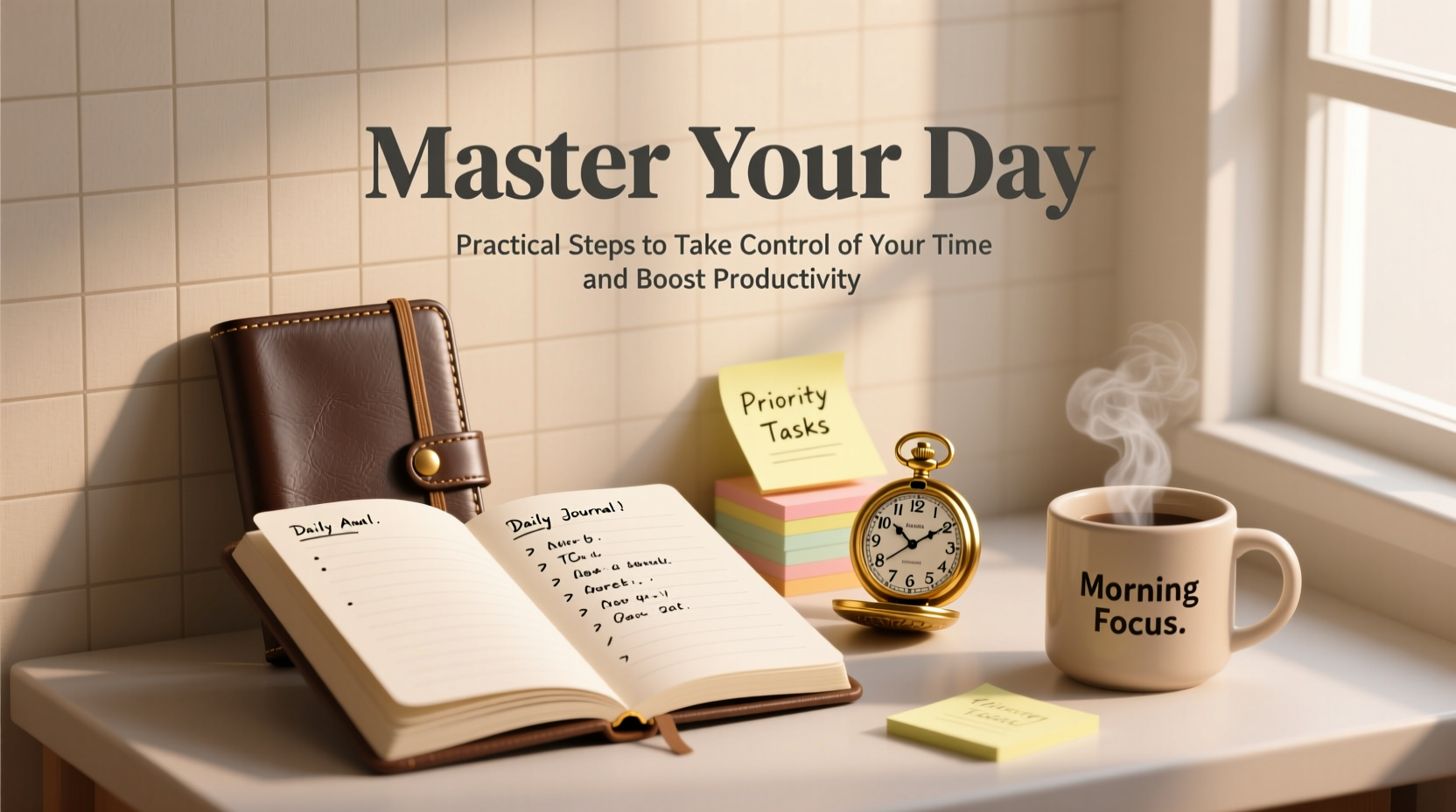In a world where distractions are constant and demands on our attention grow daily, mastering your time isn’t just helpful—it’s essential. Productivity isn’t about doing more; it’s about doing what matters with clarity and intention. The difference between a chaotic day and a purposeful one often comes down to small, consistent choices. By rethinking how you plan, prioritize, and protect your energy, you can shift from reacting to each moment to leading your schedule with confidence.
Start with Purpose: Define Your Daily Intentions

Before diving into tasks, begin with a clear sense of direction. Without intention, even a full to-do list can leave you feeling unaccomplished. Each morning—or the night before—take five minutes to define your top three priorities. These should align with your long-term goals, whether personal or professional.
Ask yourself: What would make today feel meaningful? Which tasks, if completed, would reduce stress or move a project forward significantly? This practice shifts focus from volume to value.
The Power of Time Blocking
Calendars filled with meetings and vague entries like “work on project” lack structure. Time blocking transforms your schedule by assigning specific tasks to dedicated periods. Instead of asking, “What should I do now?” you consult your plan and follow through.
For example, block 9:00–10:30 AM for deep work, 1:00–1:30 PM for email, and 3:00–3:45 PM for team check-ins. This method reduces decision fatigue and increases accountability.
“Time blocking is the single most effective strategy I use to maintain high output without burnout.” — Cal Newport, author of *Deep Work*
Eliminate Hidden Time Thieves
Productivity isn’t just about adding better habits—it’s also about removing what drains your focus. Common culprits include unchecked notifications, multitasking, and poorly defined task boundaries.
- Notifications: Turn off non-essential alerts on your phone and computer. Schedule two to three designated times to check messages.
- Open Tabs & Apps: Each open tab competes for mental space. Close everything unrelated to your current task.
- Meeting Creep: Decline invitations that don’t require your input. Suggest asynchronous updates instead.
| Time Thief | Impact | Solution |
|---|---|---|
| Unscheduled Email Checks | Breaks flow, reduces focus | Check email only at set times (e.g., 10:00 AM, 2:00 PM, 4:30 PM) |
| Back-to-Back Meetings | Mental fatigue, reduced creativity | Leave 15-minute buffers between calls |
| Task Switching | Lowers quality, increases errors | Work in focused 25–50 minute intervals |
Design Your Ideal Work Rhythm
Not all hours are created equal. Your energy fluctuates throughout the day, and aligning tasks with your natural rhythm leads to higher efficiency and satisfaction.
Most people experience peak mental clarity within 2–4 hours of waking. Use this window for demanding cognitive work—writing, problem-solving, strategic planning. Save routine tasks like admin, scheduling, or light reading for lower-energy periods.
Step-by-Step Guide: Build Your Daily Flow
- Track your energy for three days: Note when you feel most alert, creative, or sluggish.
- Categorize your tasks: Label them as Deep Work, Routine, or Communication-based.
- Match tasks to energy levels: Assign high-focus tasks to peak hours.
- Schedule breaks: Include short walks, stretching, or mindfulness after intense blocks.
- Review and adjust weekly: Refine your rhythm based on what worked.
A Real Example: How Sarah Reclaimed Her Workday
Sarah, a marketing manager, used to start her day checking emails, which left her reactive and overwhelmed by noon. She’d attend meetings with no preparation and end each day with unfinished projects.
After implementing time blocking and setting her top three priorities each morning, she began reserving 8:00–9:30 AM for campaign strategy—her most critical work. She silenced notifications and scheduled email checks for 10:00 AM and 3:00 PM. Within two weeks, she completed a delayed client proposal ahead of deadline and reduced overtime by five hours per week.
Her transformation wasn’t due to working harder—but to working with greater intention.
Build Sustainable Habits with a Weekly Reset
Daily planning sets the stage, but weekly reflection ensures consistency. Set aside 30 minutes every Friday or Sunday evening to review the past week and prepare for the next.
📋 Weekly Reset Checklist:- Review completed tasks and celebrate progress
- Identify what derailed your focus
- Plan top three goals for the upcoming week
- Time-block key appointments and deep work sessions
- Clear inbox to under 20 messages
- Update project trackers or task lists
This ritual prevents tasks from slipping through the cracks and gives you a sense of control before the week begins.
Frequently Asked Questions
How do I stay productive when my schedule is unpredictable?
Even in dynamic environments, anchor your day with one non-negotiable block of focused work. Protect this time like a critical meeting. Use micro-planning: at the start of each day, identify just two key outcomes. Flexibility doesn’t mean chaos—structure enables agility.
What if I get interrupted despite planning?
Interruptions are inevitable. When they occur, assess urgency: does this require immediate attention, or can it wait? If it can wait, jot it down and return to it during a designated buffer period. Communicate your focus blocks to colleagues so they understand your availability.
Is multitasking ever effective?
Rarely. True multitasking—performing two cognitively demanding tasks simultaneously—reduces accuracy and increases completion time. Exceptions include pairing a physical activity (like walking) with low-effort thinking (like brainstorming). Otherwise, single-tasking delivers superior results.
Conclusion: Take Control One Day at a Time
Mastering your day doesn’t require drastic overhauls or superhuman discipline. It starts with small, deliberate actions: defining priorities, protecting focus, and aligning effort with energy. Over time, these practices compound into greater clarity, reduced stress, and meaningful progress.
You don’t need more hours—you need better ownership of the ones you have. Begin tomorrow with a clear intention, a structured plan, and the confidence that you’re in charge of your time.









 浙公网安备
33010002000092号
浙公网安备
33010002000092号 浙B2-20120091-4
浙B2-20120091-4
Comments
No comments yet. Why don't you start the discussion?